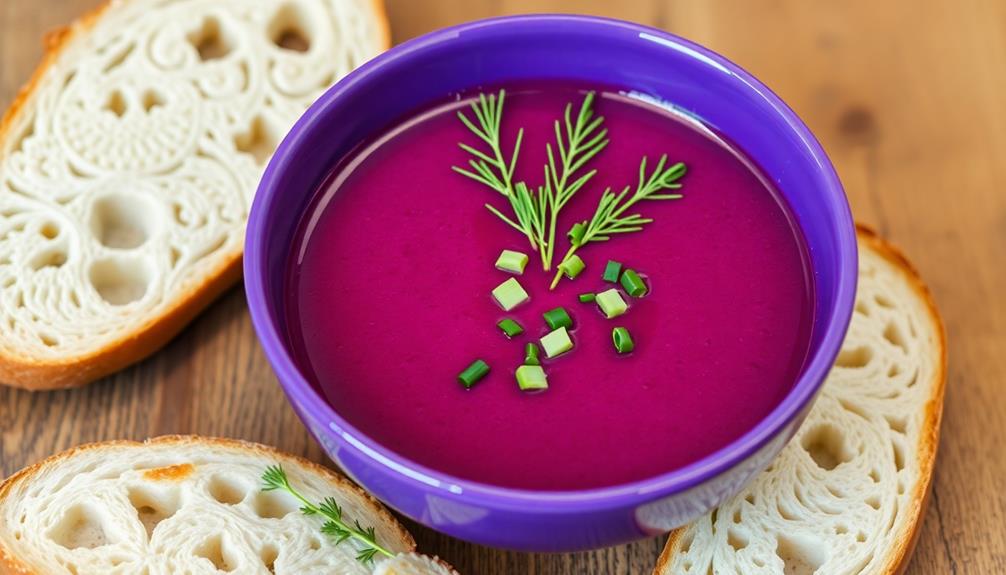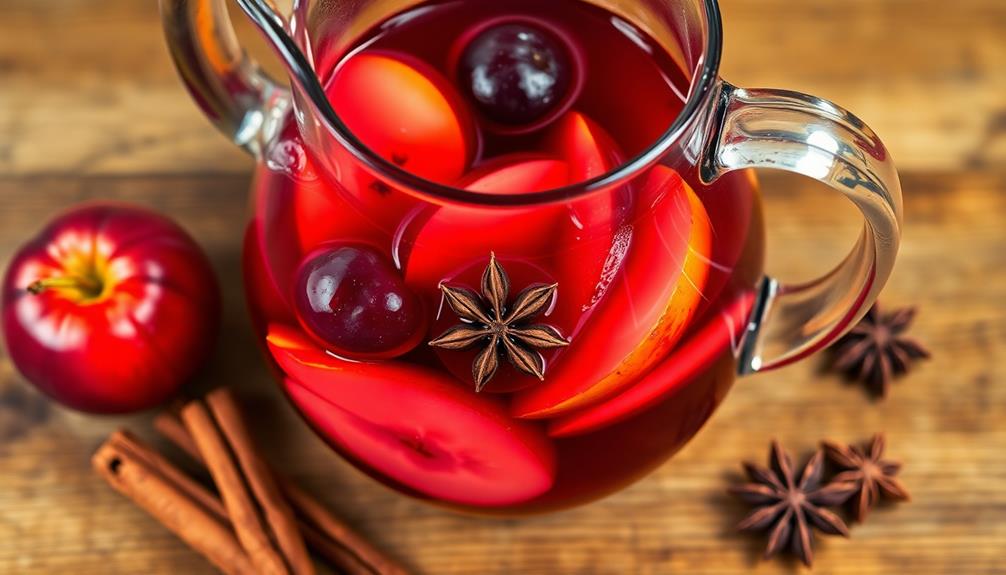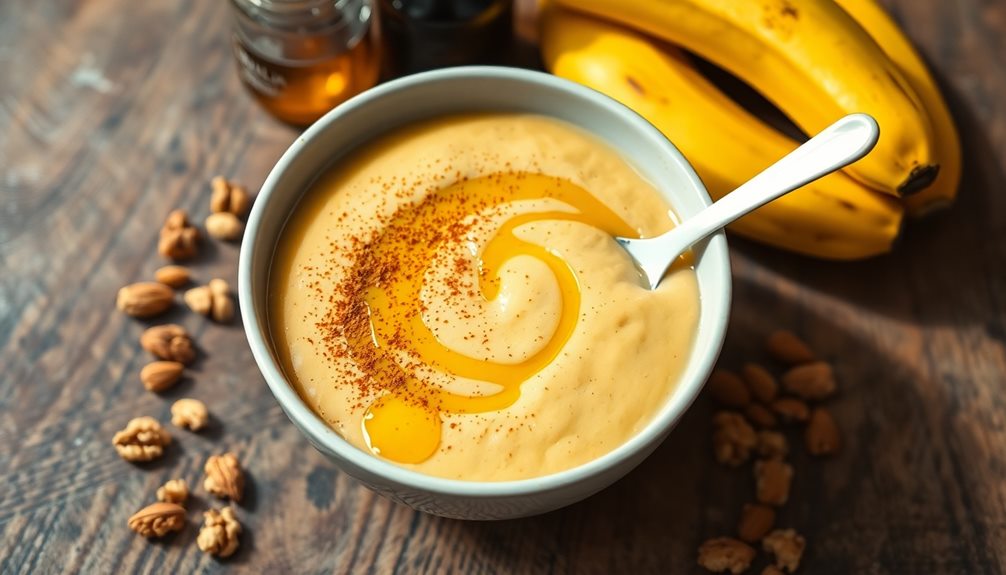Cold beet soup is a vibrant and refreshing dish that'll whisk you away to the streets of Eastern Europe. Its roots run deep, blending the earthy sweetness of beets with tangy yogurt and aromatic herbs to create a visually stunning and flavorful summer staple. Whether you're craving a light starter or a chilled main, this ruby-red soup checks all the boxes. Serve it up with crusty bread and get ready to be wowed by its nutritious benefits and satisfying flavors. Want to learn more about the captivating history and mouthwatering variations of this cold beet delight?
Key Takeaways
- Cold beet soup is a refreshing and vibrant dish, ideal for summer, originating from Eastern European culinary traditions.
- The soup combines the earthy sweetness of beets with tangy yogurt and fresh herbs, creating a unique blend of flavors.
- Key ingredients include beets, Greek yogurt, broth, lemon juice, garlic, dill, and chives, often served chilled with crusty bread or crackers.
- Cold beet soup is nutrient-dense, rich in vitamins, antioxidants, and dietary fiber, making it a healthy choice.
- The soup's flavor profile features a balance of sweet, sour, and earthy notes, enhanced by garnishes for added texture and visual appeal.
History
A rich and vibrant history surrounds the origins of cold beet soup, tracing its roots back to Eastern European culinary traditions. This beloved dish has been a staple in the region for centuries, with records of similar beet-based soups dating back to the 16th century.
Over time, the recipe has evolved, reflecting the diverse cultural influences that have shaped the cuisine of Eastern Europe.
The distinct ruby-red hue of cold beet soup, known as chłodnik in Polish or borscht in Russian, is a testament to the humble yet versatile beet. These nutrient-dense roots have long been celebrated for their earthy sweetness and vibrant color, making them an integral component of many traditional dishes.
As the soup spread across borders, local variations emerged, each one showcasing the unique flavors and ingredients of its respective region.
Recipe
Cold Beet Soup is a refreshing and vibrant dish that showcases the earthy sweetness of beets. This chilled soup is perfect for a hot summer day, offering a cooling and nourishing option.
The combination of beets, tangy yogurt, and fragrant herbs creates a delightful balance of flavors. The vibrant color of the soup also makes it a visually appealing addition to any meal.
Ingredients:
- 3 medium-sized beets, peeled and diced
- 1 cup plain Greek yogurt
- 2 cups vegetable or chicken broth
- 2 tablespoons lemon juice
- 1 garlic clove, minced
- 2 tablespoons fresh dill, chopped
- 1 tablespoon fresh chives, chopped
- Salt and pepper to taste
Instructions:
In a large saucepan, bring the vegetable or chicken broth to a boil. Add the diced beets and cook until tender, about 15-20 minutes. Drain the beets and let them cool completely.
In a blender or food processor, combine the cooked beets, yogurt, lemon juice, garlic, dill, and chives. Blend until smooth and creamy. Season with salt and pepper to taste.
Chill the soup in the refrigerator for at least 2 hours before serving. Garnish with additional dill and chives, if desired.
Tips:
For a thicker consistency, you can add more yogurt to the soup. Conversely, if you prefer a thinner soup, add more broth. Roasting the beets instead of boiling them can also add depth of flavor to the soup.
Serve the cold beet soup with crusty bread or crackers for a complete and satisfying meal.
Cooking Steps
Peel those beets and grate them up!
Next, stir in some sour cream and a squeeze of lemon juice.
Don't forget to sprinkle in the chopped fresh dill.
Once everything's mixed together, pop the soup in the fridge to chill before serving.
And don't be shy with the sugar – add a little to taste until it's just right!
Step 1. Peel and Grate the Beets

First, take the beets and thoroughly scrub them under running water to remove any dirt or debris.
Once they're clean, you'll need to peel off the tough outer skin. Use a sharp knife or vegetable peeler to carefully remove the skin, being cautious not to waste too much of the vibrant red flesh.
Next, grab a box grater and grate the peeled beets using the largest holes. Work slowly and steadily, grating the beets into thin, delicate shreds. The goal is to create a fine, even texture that will blend seamlessly into the soup.
As you grate, you may want to gather the shredded beets into a bowl to make the next step easier.
Grating the beets by hand takes a bit of elbow grease, but it's worth the effort to get that perfect texture. Just take your time and enjoy the satisfying "thwack" as the beets hit the grater.
Step 2. Add Sour Cream and Lemon
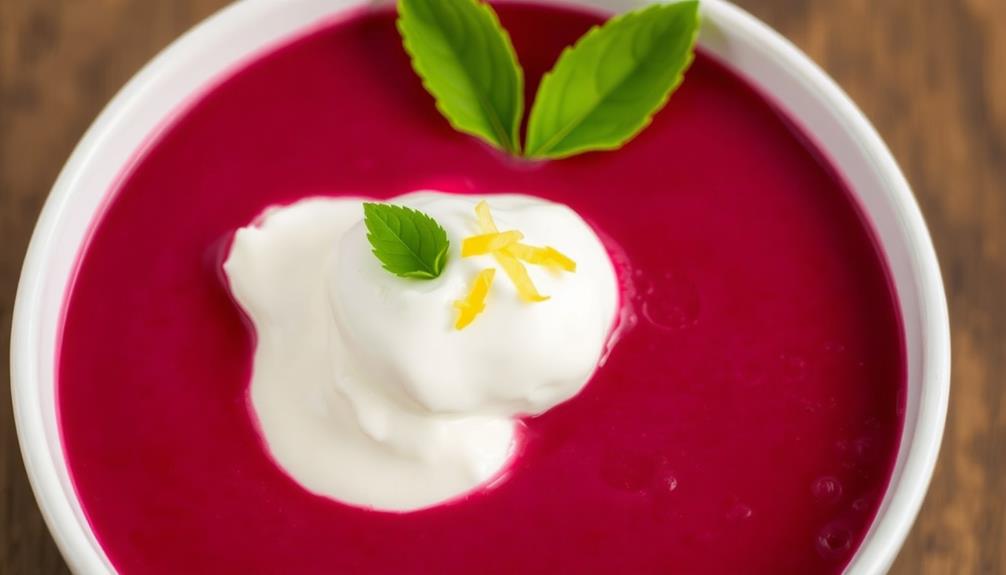
With the beets grated to perfection, it's time to introduce the cool and tangy elements that will transform this soup into a refreshing delight.
First, you'll want to add a generous dollop of sour cream to the mix. The cool, creamy texture will provide a beautiful contrast to the earthy beets, while the slight tanginess will help to balance the sweetness.
Next, give the soup a bright and citrusy kick by squeezing in the juice of half a lemon. The lemon's zesty notes will awaken your taste buds, cutting through the richness and bringing the entire flavor profile into harmony.
Gently stir the sour cream and lemon juice into the grated beets, blending the ingredients together until the soup takes on a velvety, homogeneous consistency.
The end result will be a chilled, aromatic masterpiece that's sure to delight your senses and leave you craving more.
Step 3. Add Chopped Dill
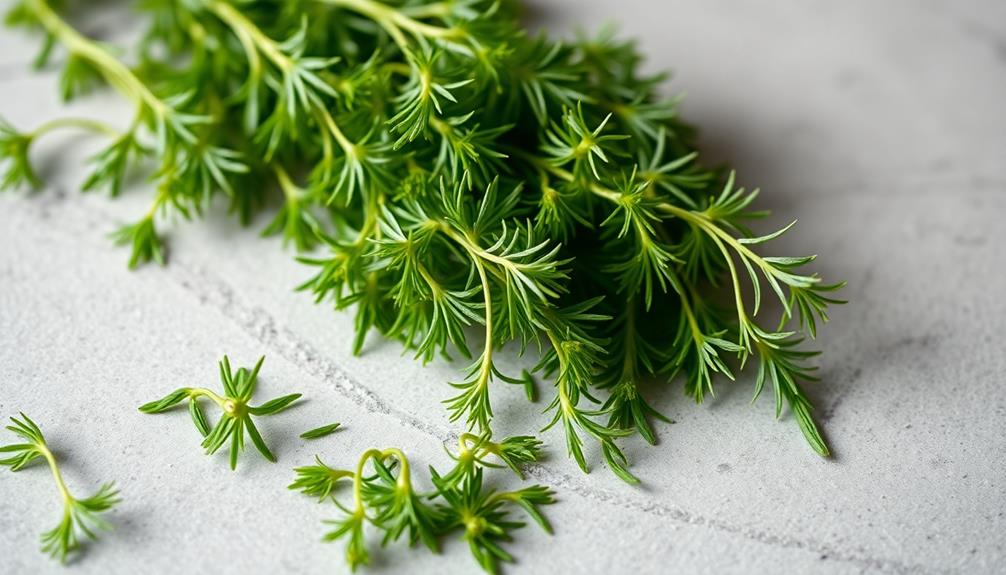
Next, grab a handful of fresh dill and give it a rough chop. The fragrant, feathery sprigs will add a lovely herbal note to your cold beet soup.
Incorporating fresh herbs like dill not only enhances the flavor but also aligns with the idea of maintaining high vibrational energy in your meals, much like mindset shifts necessary for achieving weight loss goals.
Sprinkle the chopped dill over the velvety purple soup, letting it float on the surface. Its bright green hue provides a beautiful contrast against the deep, earthy beet color.
The dill's distinct, slightly grassy flavor complements the sweetness of the beets perfectly. As you take a spoonful, the cool soup and the aromatic dill dance together on your tongue, creating a refreshing and balanced taste.
The dill also adds a delightful crunch, elevating the smooth, velvety texture of the soup.
Don't be shy with the dill – the more you add, the more pronounced that fresh, summery flavor will be.
Garnish each bowl generously, then invite your family and friends to savor this vibrant, herbaceous chłodnik together.
Step 4. Chill the Soup Before Serving
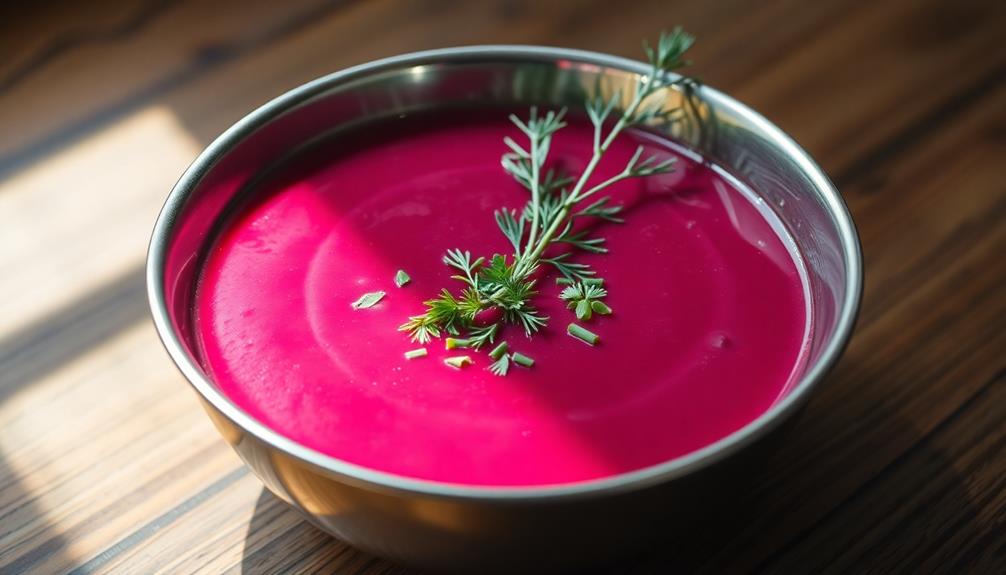
Once the dill is sprinkled over the soup, it's time to chill the dish before serving. Place the pot of soup in the refrigerator and let it cool for at least 2 hours. This will allow the flavors to meld and the soup to reach a refreshing, chilled temperature.
Chilling the soup is an important step, as it enhances the earthy sweetness of the beets and the bright, herbaceous notes of the dill. Additionally, this soup can be complemented with a touch of butter for richness, though it's important to be mindful of moderation due to its high calorie content.
As the soup chills, the vibrant fuchsia color will deepen, creating a visually stunning presentation. When you're ready to serve, ladle the cold soup into bowls and garnish each portion with an extra sprinkle of dill.
The cool, velvety texture and bold, piquant flavor will be a delightful contrast to the hot summer day. Enjoy this nourishing, vegetable-forward soup as a light and refreshing starter or a satisfying main course.
Step 5. Add Sugar to Taste
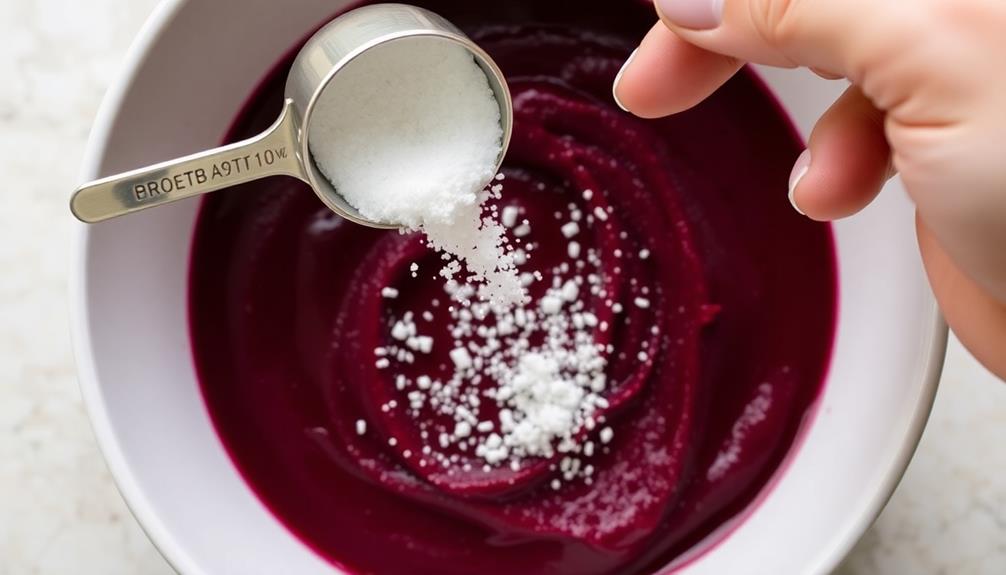
After chilling the soup, taste it and determine if it needs any additional sweetness.
Beets have a naturally earthy, slightly bitter flavor, so a touch of sugar can help balance the taste.
Start by adding a teaspoon of white granulated sugar and stir it in until dissolved.
Give the soup another taste – if it's still not quite sweet enough for your liking, add another teaspoon of sugar.
Continue this process, tasting after each addition, until the soup reaches your desired level of sweetness.
Be careful not to over-sweeten, as you want the beet flavor to still shine through.
The perfect cold beet soup strikes a harmonious balance between the earthy beets and the subtle sweetness.
Once it's just right, your soup is ready to serve and enjoy on a hot summer day.
Final Thoughts
Overall, this refreshing cold beet soup is a delightful summertime dish. You'll be amazed by the vibrant color and tangy flavor that the beets provide.
The creaminess from the sour cream or yogurt is a perfect complement, while the fresh dill and lemon juice add a bright, herbal note. Don't be afraid to experiment with garnishes – a sprinkle of toasted walnuts or crumbled feta cheese can take this soup to the next level.
Whether you serve it as a starter or a light main course, this chłodnik is sure to impress your guests. The blend of sweet, sour, and earthy flavors creates a truly unique and satisfying experience.
Plus, it's a great way to incorporate more nutrient-dense beets into your diet. So, the next time you're looking for a refreshing and vibrant summer soup, give this cold beet soup a try. Your taste buds will thank you!
Frequently Asked Questions
What Is the Origin of the Name "ChłOdnik"?
You know, the name "chłodnik" really intrigues me!
It's got this cool, almost mysterious sound to it, doesn't it? As it turns out, the word comes from the Polish root "chłód," which means "coolness" or "cold."
So the name "chłodnik" literally translates to "cold soup" – how clever is that?
It's a perfect description for this refreshing, chilled dish.
Don't you just love when a name so perfectly captures the essence of the food?
It makes me even more excited to try this tasty soup!
How Long Can ChłOdnik Be Stored Before Serving?
You can store chłodnik in the fridge for up to 5 days before serving. Just be sure to keep it chilled and covered.
The cool, refreshing flavors will stay crisp and vibrant, so you can enjoy this tasty soup whenever the mood strikes!
The bright, jewel-toned color of the beets is eye-catching, and the creamy, tangy broth is simply delightful.
Go ahead, give chłodnik a try – your taste buds will thank you!
Can ChłOdnik Be Made With Other Types of Beets?
Absolutely! You can make this tasty soup with different types of beets.
Red, golden, and even rainbow beets work great. The flavor will vary slightly, but they'll all give you that vibrant, earthy taste you love.
Just remember to adjust the cooking time based on the beet variety – some may need a bit more or less time to reach that perfect tenderness.
Get creative and try out different beet combos to find your new favorite version!
What Is the Ideal Temperature for Serving ChłOdnik?
The ideal temperature for serving chłodnik is chilled, around 50-60°F (10-15°C).
This refreshing cold soup is meant to be enjoyed on a warm day, providing a cool and invigorating experience.
Serve it straight from the fridge, or even with a few ice cubes to keep it extra cold.
The crisp, vibrant flavors really shine when the chłodnik is nicely chilled.
Experiment with the temperature to find your perfect balance of refreshment!
Is ChłOdnik Commonly Consumed Throughout Poland or Only in Certain Regions?
You're in for a treat! Chłodnik, the cold beet soup, is a beloved dish that's enjoyed throughout Poland.
While it might be more common in certain regions, this vibrant, refreshing soup has made its way into the hearts and kitchens of people across the country. There’s something about the combination of ripe tomatoes, savory broth, and a hint of cream that just hits the spot. Whether you’re whipping up a batch to warm up on a chilly evening or serving it chilled on a hot summer day, this creamy tomato soup recipe is a beloved classic. With just a few simple ingredients and a bit of time on the stove, you can enjoy a bowl of this comforting soup anytime.
Whether you're sipping it on a hot summer day or savoring it as a unique appetizer, chłodnik is a true taste of Polish culture that's sure to delight your senses.
